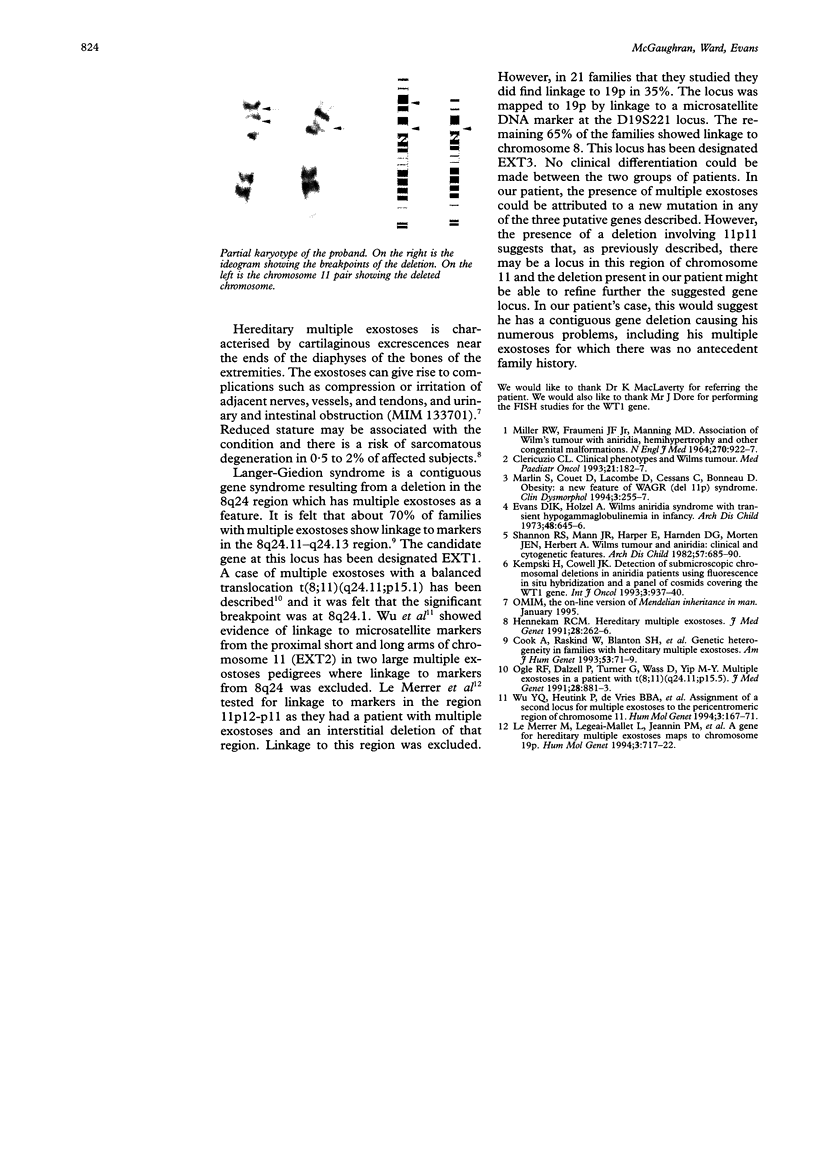Abstract
The WAGR syndrome (Wilms' tumour, aniridia, genital anomalies, and mental retardation) is well documented to be associated with a deletion of 11p13. We present a patient with a del(11)(p11.2p14.2) who as well as all the features of WAGR syndrome has multiple exostoses. We suggest that this could be a possible locus for hereditary multiple exostoses.
Full text
PDF

Images in this article
Selected References
These references are in PubMed. This may not be the complete list of references from this article.
- Clericuzio C. L. Clinical phenotypes and Wilms tumor. Med Pediatr Oncol. 1993;21(3):182–187. doi: 10.1002/mpo.2950210306. [DOI] [PubMed] [Google Scholar]
- Cook A., Raskind W., Blanton S. H., Pauli R. M., Gregg R. G., Francomano C. A., Puffenberger E., Conrad E. U., Schmale G., Schellenberg G. Genetic heterogeneity in families with hereditary multiple exostoses. Am J Hum Genet. 1993 Jul;53(1):71–79. [PMC free article] [PubMed] [Google Scholar]
- Evans D. I., Holzel A. Wilm's-aniridia syndrome with transient hypo-gamma-globulinaemia of infancy. Arch Dis Child. 1973 Aug;48(8):645–646. doi: 10.1136/adc.48.8.645. [DOI] [PMC free article] [PubMed] [Google Scholar]
- Hennekam R. C. Hereditary multiple exostoses. J Med Genet. 1991 Apr;28(4):262–266. doi: 10.1136/jmg.28.4.262. [DOI] [PMC free article] [PubMed] [Google Scholar]
- Le Merrer M., Legeai-Mallet L., Jeannin P. M., Horsthemke B., Schinzel A., Plauchu H., Toutain A., Achard F., Munnich A., Maroteaux P. A gene for hereditary multiple exostoses maps to chromosome 19p. Hum Mol Genet. 1994 May;3(5):717–722. doi: 10.1093/hmg/3.5.717. [DOI] [PubMed] [Google Scholar]
- MILLER R. W., FRAUMENI J. F., Jr, MANNING M. D. ASSOCIATION OF WILMS'S TUMOR WITH ANIRIDIA, HEMIHYPERTROPHY AND OTHER CONGENITAL MALFORMATIONS. N Engl J Med. 1964 Apr 30;270:922–927. doi: 10.1056/NEJM196404302701802. [DOI] [PubMed] [Google Scholar]
- Marlin S., Couet D., Lacombe D., Cessans C., Bonneau D. Obesity: a new feature of WAGR (del 11p) syndrome. Clin Dysmorphol. 1994 Jul;3(3):255–257. [PubMed] [Google Scholar]
- Ogle R. F., Dalzell P., Turner G., Wass D., Yip M. Y. Multiple exostoses in a patient with t(8;11)(q24.11;p15.5). J Med Genet. 1991 Dec;28(12):881–883. doi: 10.1136/jmg.28.12.881. [DOI] [PMC free article] [PubMed] [Google Scholar]
- Shannon R. S., Mann J. R., Harper E., Harnden D. G., Morten J. E., Herbert A. Wilms's tumour and aniridia: clinical and cytogenetic features. Arch Dis Child. 1982 Sep;57(9):685–690. doi: 10.1136/adc.57.9.685. [DOI] [PMC free article] [PubMed] [Google Scholar]
- Wu Y. Q., Heutink P., de Vries B. B., Sandkuijl L. A., van den Ouweland A. M., Niermeijer M. F., Galjaard H., Reyniers E., Willems P. J., Halley D. J. Assignment of a second locus for multiple exostoses to the pericentromeric region of chromosome 11. Hum Mol Genet. 1994 Jan;3(1):167–171. doi: 10.1093/hmg/3.1.167. [DOI] [PubMed] [Google Scholar]



